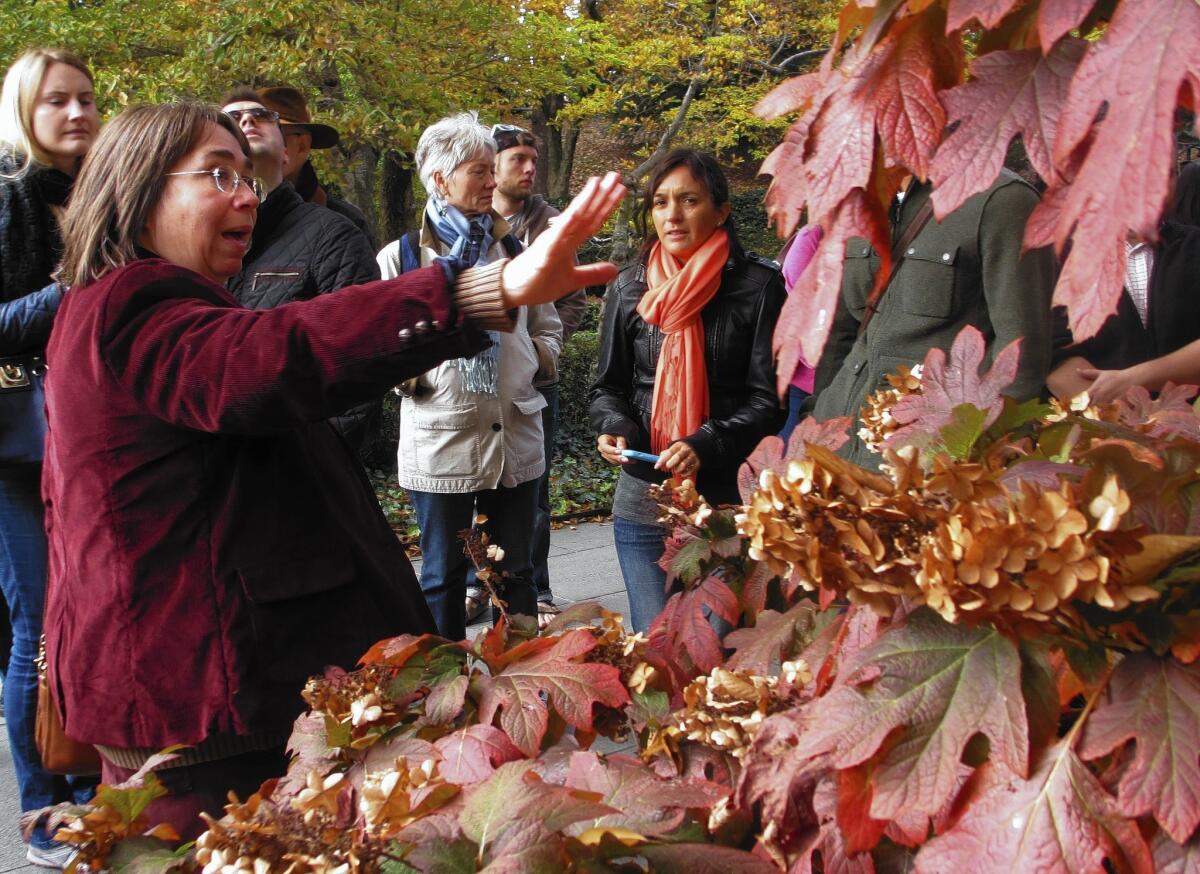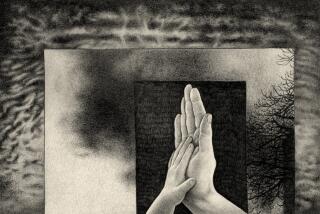For some New Yorkers, beating ‘winter blues’ is a walk in the park

- Share via
NEW YORK — Karyn Anastasio would have preferred staying in bed, ignoring the early onset of cold and darkness as she huddled in her apartment and watched TV.
Instead, Anastasio and her friend, Christina Kaelberer, who also dreads winter, were walking through the Brooklyn Botanic Garden and listening to a tiny woman rave about the surroundings and emphasize how lovely they would be when ice covered the ponds, when white coated the ground, when the sky was gray.
In other words, when it was very, very cold.
“If you come here in the snow, it’s delightful,” the woman, Lynne Spevack, said as she stood beside a red-twig dogwood bush. “It’s really quite beautiful.”
If Spevack, a licensed social worker and psychotherapist, sounded slightly insistent, it’s because this was no mere nature walk. It was part of Spevack’s annual effort to help Northeasterners fend off the “winter blues,” which in its worst form is recognized by medical professionals as a type of depression called seasonal affective disorder, or SAD.
Spevack can expect to be busy this winter, which officially begins Saturday. New York and the rest of the Northeast already have seen several snowfalls this month. The National Weather Service says 98.9% of the Northeast has some snow cover, compared with 63.2% at this time last year. “This winter is shaping up to be a rough one,” said Janice Stillman, editor of the Old Farmer’s Almanac, which predicts below-normal temperatures and above-normal snowfall across most of the country.
SAD is triggered by shorter days — cold and snowy or not.
“There’s nothing crackpot about the winter blues,” said Michael Terman, a psychiatrist at Columbia University who has studied the ailment since the National Institute of Mental Health recognized it in the 1980s.
Terman founded New York’s Center for Light Treatment and Biological Rhythms to treat sufferers, whose affliction is linked to melatonin. When it’s dark, the body produces more of the sleep-inducing hormone, and in some people this translates to debilitating body-clock issues.
People with the disorder are likely to hibernate like bears, oversleeping and avoiding venturing outside from fall through winter. They become gloomy, unproductive and moody. They are tired, and they crave foods high in carbohydrates, leading to weight gain.
The symptoms are found in the general population, but there’s a major difference among people with the disorder: Their symptoms are seasonal, coming on in late fall or early winter, and lifting like clockwork in spring, when the days grow longer.
In one study, Terman found that people living on the western edges of time zones reported suffering from the disorder more than those living in the same time zones’ eastern edges.
“There’s a simple explanation. The sun is rising an hour later as you hit the western edge,” said Terman, who estimates that 5% of the U.S. population suffers from the most serious form of winter blues. Most, like Spevack, live in Northern states, which in fall and winter receive far less sunlight than those in the South.
“I hate the cold,” said Spevack, who began noticing her problem in college in Poughkeepsie, in northern New York state. Each November, the symptoms would turn the usually social Spevack into someone who could barely get out of bed.
“You get kind of a brain fog,” said Spevack, who sought help from Terman.
She began using a light box at home and in her office to replicate sunlight, and a dawn simulator to help her wake up in the morning. Simulators fill a room with light that resembles the slowly rising sun. Some offer sounds, such as twittering birds, to accompany the growing light.
Spevack began forcing herself to take a walk outside each day, no matter how miserable the weather, to soak in some natural light. During one of those walks about 10 years ago, she was in the Brooklyn Botanic Garden. It was a cold day, and Spevack was alone, but she noticed the snaps of color against the otherwise monochrome landscape, and details such as rabbit tracks in the snow.
“The thought occurred to me that it would be a good idea to start giving tours aimed at people who suffer in winter,” said Spevack, who does not charge for her guided walks.
When she first started the “Chase Away the Winter Blues” walks, Spevack would simply corral strolling strangers and point out details that tend to go unnoticed when people’s faces are swaddled in heavy scarves, hats and hoods.
The walks caught on, and now a dozen to 50 or more people show up on the first Sunday of each month, starting in November and ending in March.
Spevack kept up a quick pace, darting from one section of the botanic garden to another with about 25 people trailing close behind.
“This is great! Join me here,” she said, stopping to admire a huge beech tree and pointing out its rounded crown against the cloud-studded sky.
Spevack moved on to a ginkgo tree, whose seeds, she conceded, smell “like vomit,” but whose fan-shaped leaves turn a buttery yellow in the fall.
Anastasio, 50, doesn’t consider herself a severe winter blues sufferer, but she had struggled to make it to this walk, even though it didn’t begin until 1 p.m.
“I was watching ‘Law and Order’ and thinking I could just sit there all day,” Anastasio said.
Her friend, Kaelberer, a pastry chef who spends most of her day in a restaurant kitchen, had talked her into coming. Kaelberer said depression runs in her family, and she had recognized within herself a tendency to hibernate in the winter.
“When it starts to get cold, I get a little crazy. It’s hard to get up in the morning,” said Kaelberer, who sees the walks as preferable to antidepressants. “I want to have a reason to get outdoors. I don’t want to be on any drugs.”
Spevack worries that technology is making it harder for people to treat the winter blues. The ability to do most things online — buying Christmas gifts, banking, even grocery shopping — makes it easy to never leave home. That deprives people of the natural light that alleviates the disorder.
Terman said at least two of his patients tried to cure themselves by moving from New York to more southern latitudes.
Anastasio said she understood.
“I used to laugh at people who would say, ‘When I’m older, I’m going to move to Florida,’” she said. “Well, now I’m older, and I want to move to Florida.”
ve to Florida.”
More to Read
Sign up for Essential California
The most important California stories and recommendations in your inbox every morning.
You may occasionally receive promotional content from the Los Angeles Times.











